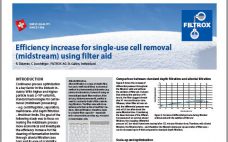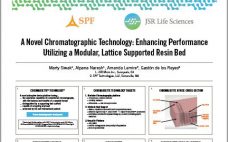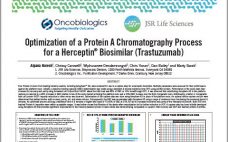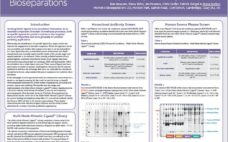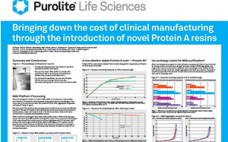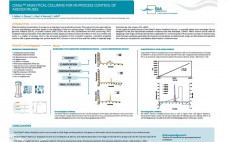Continuous process optimization is a key factor in the biotech in-dustry. With higher and higher particle loads (>108 cells/ml), standard technologies for cell removal (midstream processing) – e.g. centrifugation, separation, membrane- and depth filtration – find their limits. The goal of the following study was to focus on making the midstream process more economical and investigate the efficiency increase for the cleaning of fermentation broths through alluvial filtration (see box) and its ease of scalability. This technology leads to a…
Downstream Processing
A Novel Chromatographic Technology: Enhancing Performance Utilizing a Modular, Lattice Supported Resin Bed
This poster highlights the Chromacassette® Technology: First practical modular chromatography platform. Supported-bed enables packing of any resin bead. Constant bed permeability, independent of resin compressibility even at V > 1000 cm/hr. Truly linear scalable. Eliminates packing methods and equipment. New operating domains and resin design are now possible for both bind and elute and flow-through. Hyper-Productive™ process enabling for single-use chromatography. PD devices will be available early 2018.
Optimization of a Protein A Chromatography Process for a Herceptin® Biosimilar (Trastuzumab)
Four Protein A resins from leading industry vendors, including Amsphere™ A3, were screened for use in a capture step for a Herceptin biosimilar. Multiple parameters were assessed for their performance against the platform resin. Initially, a dynamic binding capacity (DBC) determination was made using a standard 4-minute residence time (RT) using purified protein. Performance of the resins were then screened for recovery and purity using harvested cell culture fluid (HCCF) where the MAb load was 80% of DBC at 10%…
Comparative Study of Commercially Available Protein A Chromatography Resins and Amsphere™ A3
Host cell proteins (HCPs) in biopharmaceuticals must be controlled in the downstream process (DSP) of antibody production, since it has critical influence on product quality. Generally, the majority of HCPs in harvested cell culture fluid are removed during the affinity step using Protein A chromatography resin, and the remaining HCPs are remove in the polishing step by a combination of ion-exchange chromatography, hydrophobic interaction chromatography, etc. Thus, identification of remaining HCPs after Protein A affinity chromatography process can work as…
Multi-Mode Mimetic Ligand™ Library – A Rapid Screening Toolbox for Target Protein Purification
Small synthetic ligands have established themselves as an essential component of modern downstream processes, both as specific ligands for product capture or the targeted removal of impurities and more generally for product polishing applications. Historically, the identification of a specific ligand for a target protein has required the engagement of specialist companies. Whilst this approach can be very successful, such studies often require some time to set-up and perform (i.e. from ligand discovery, to adsorbent/process development and finally manufacture) and…
Rapid and Simple Sample Preparation for High Throughput, High Resolution and Sensitive Glycan Analysis by Capillary Electrophoresis
Here, we report the simple and rapid GlycanAssure™ workflow that combines high throughput and high resolution glycan analysis of 96 samples in 7-9 hours using Applied Biosystems™ 3500xL 24-capillary electrophoresis system. The process eliminates vacuum drying and highly toxic cyanoborohydride in the labeling reaction. Use of Dynabeads™ magnetic beads for glycan purification post deglycosylation and removal of free dyes after labeling streamlines the process for automation. Capillary electrophoresis can detect less than 0.2 fmol/ÎĽL of labeled glycans. Two proprietary fluorescent…
Innovative Hydrophobic Interaction Chromatography (HIC) Resins for Next Generation Molecule Challenges
Advances in biotherapeutics are generating a wider range of biomolecules that are presenting unique and often difficult separation and purification challenges. Based on the complex needs of the industry a series of HIC prototypes were developed over a range of hydrophobicity. Utilizing extensive user input, design goals focused on development of resins with market leading resolution and capacity, as well as optimized surface and flow characteristics for increased throughput and high product recovery. All of which are typical pain points…
Decreasing Cost of Clinical Trials Through the Use of Two Novel Protein A Resins
Tackling the High Cost of Protein A in Early Clinical Phases The cost of Protein A resins is very high, commonly 5-10 times higher compared to standard chromatography resins. One way to address this issue is to use a less expensive Protein A resin during early clinical trials, where the risk of failure is higher and fewer cycles are run, and subsequently switch to a resin designed for manufacturing if the product makes it to PIII and beyond. The higher…
A Fresh Approach to Process and Cost Efficiencies in Early Clinical and Biosimilars Production
This poster will introduce Praesto™ AC protein A resin and ProcessReady pre-packed columns from Purolite. Platform processes for MAbs manufacturing have long been used to save time and costs. The use of highly productive, cost- effective resins in such platforms can magnify these savings, and the addition of ready-to use formats can further enhance process efficiencies. Our approach is to maximize these efficiencies and cost savings in early clinical-phase production and in the manufacture of biosimilars by using stage-appropriate materials…
CIMac™ Analytical Columns for In-Process Control of Adenoviruses
Determining the concentration of viruses is a crucial step in any production process. The most commonly used methods for virus quantification are either based on the infectivity of the virus (plaque assay, TCID50) determination of their genomic material (qPCR), or protein content (SRID, ELISA) and are very cumbersome and time consuming. HPLC analytical methods represent a fast alternative to these assays since they provide information on the virus content and purity in a matter of minutes. In this work the…

